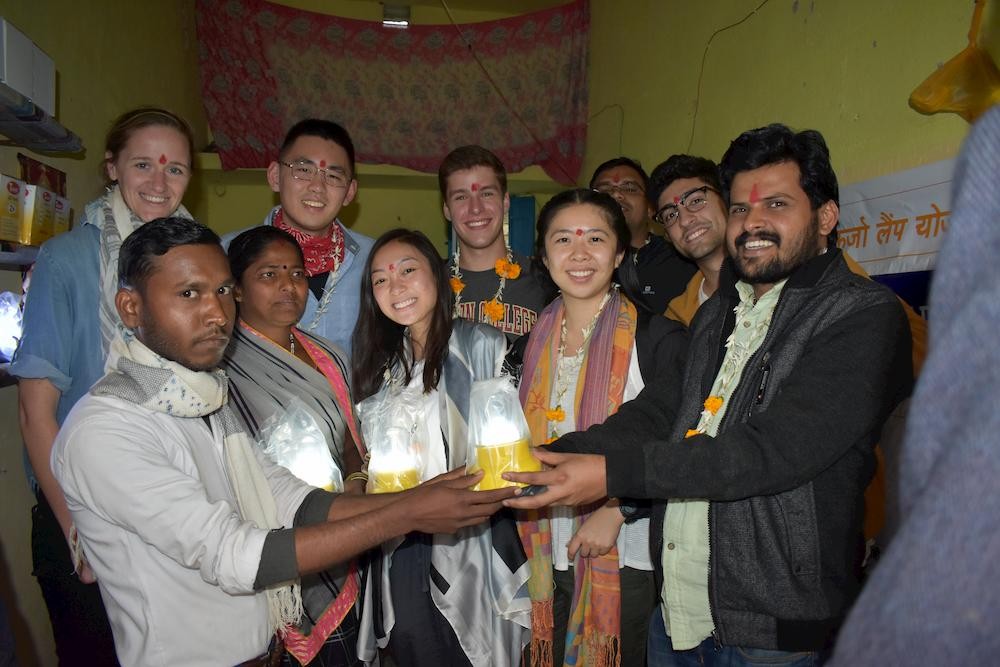The India Project: A light-filled adventure in sustainability
Life in rural India can be extremely challenging. Poverty, poor job prospects and gender inequality are just a few of the issues that continue to plague the country’s rural population. Limited access to energy is another. But now, with $30 billion in clean energy funding from India’s government and help from social enterprises like BC’s own India Project, rural India’s future is looking brighter—literally.
A collaboration between the School of Social Work (SSW) and the Indian Institute of Technology Bombay (IITB), the India Project is an independent study program now in its second year at Boston College and firmly committed to helping the people of rural India in two areas: sustainable business for women entrepreneurs and affordable access to clean energy.
Last summer, Shea Center for Entrepreneurship Director Jere Doyle asked Tammy Lee '19 and Andrew Kubicek '19 to join The India Project as part of a course called Innovation in Global Practice. The pair had served on the student executive board for Start @Shea and knew Doyle well.
Soon afterward, they met with SSW Dean Gautam Yadama and the student team from the program’s first year. And then, before he knew it, Andrew was off to Mumbai to learn about the project’s complexities firsthand.
Mind-boggling logistics
Charged with defining the scope of the project, the finance and entrepreneurship double major quickly identified his first priority: Figure out how to distribute seven million subsidized solar-powered lamps to schoolchildren and then help women entrepreneurs run 700 solar shops in rural India.
While India has been flooded with clean energy products, it lacks the supply chain to get those products to consumers. But the mind-boggling logistics are just the start of it. Compounding the problem is a lack of consumer education around which products are good and which aren’t worth the packaging they come in. A dearth of business training exacerbates the problem.
After a week in Mumbai, Andrew returned to campus to share what he had learned about the project’s logistical challenges with Tammy, a double major in information systems and marketing. Then they set the wheels in motion.
“We had early morning phone calls with India trying to understand the current state of energy access for rural areas,” Tammy said. “In some places, we found out the infrastructure wasn’t even there. Some areas had access to the grid, but couldn’t afford to pay their electric bills every month.”
During winter break in January, Andrew went back to India, this time with Tammy and three other BC students, Brian Dong ’19, Devin Hanel ’19 and Shin Cai ’19. Their mission was to visit Assam, Mumbai and Dakkar and gather more data.
“We gained an understanding once we got there of what the real needs were—things like distribution centers, repair and maintenance centers for products,” Andrew said. “We tried to understand who our customers were, visited neighborhood shops, knocked on doors in villages and talked to locals, with our IITB partners in India acting as interpreters.”
Numbers plucked from thin air
Andrew, Tammy and team spent three weeks in India before coming back to Boston, “and then came all the hard work,” Andrew said.
Armed with the data they had collected, they set out to tackle two key issues—the cost of product development and the broken retail sales process. Their first question: “Why 700 shops?” And their answer: That number had been plucked out of thin air.
“It was a lot, and we were worried about them saturating the market,” Tammy said. So the students’ first recommendation was to cut down on the number of shops to avoid cannibalizing and to spur productivity and growth.
“We built a sales model of how a store would operate,” Andrew said. “We projected revenue and found that, rather than one store owner running each shop, the optimal number of owners was three. So we recommended that three women own a shop together, split the costs three ways and do external sales.”
Based on their field research, they also found that “a lot of people weren’t even aware the solar shops existed.” So they revamped the sales training process, using a sustainable model that included customer outreach, marketing, and remarketing.
Sunny prospects
In February, the India Project team presented their plan via Skype to the project lead in India, Jayendran Venkateswaran, and his team of faculty members from IITB. The plan included a cooperative business model, a sales training manual, a financial analysis document, and an implementation timeline.
“The presentation went very well,” Andrew said. “Dean Yadama and Jere Doyle were impressed with how much we were able to accomplish.” The best part? They all got As.
Tammy, who recently accepted a position in client management at Manhattan-based Black Rock, called the India Project an amazing opportunity. “I’ve always had an interest in social entrepreneurship. And it’s not every day you get to work on an independent study with another university outside the U.S.,” she said.
As for Andrew, he’ll join Accenture in Phoenix, Arizona, as a management consultant after graduation, but he still dreams of working in social entrepreneurship someday. He looks back on the India Project as an “amazing” experience and called India “an incredible place with incredible people.”
And the India Project, for every life it touches, will continue to shed light on all sorts of exciting possibilities.



